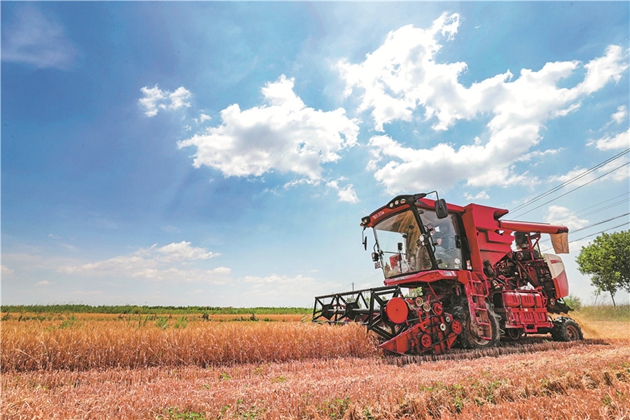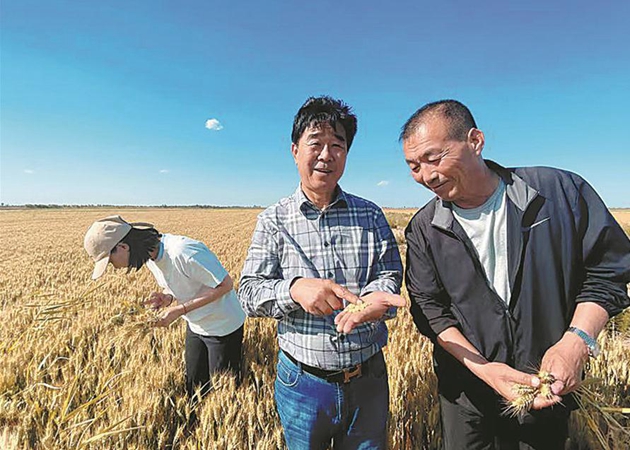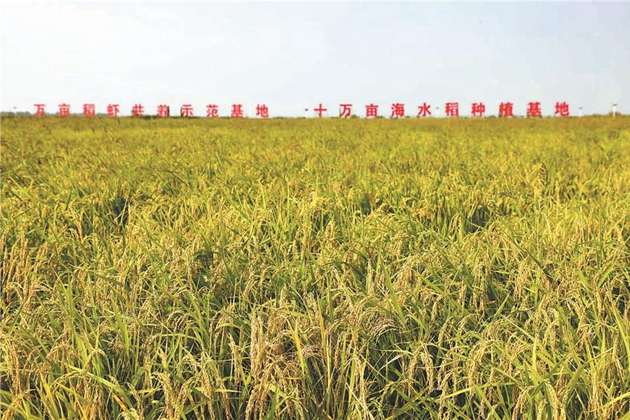Barren terrain undergoes dramatic transformation
By ZHAO RUIXUE in Weifang, Shandong| (China Daily)| Updated : 2022-11-07
Print Print
A harvester gathers wheat grown on salt-affected land in Lijin county, Dongying, Shandong province, in June. [Photo/China Daily]
Hard work pays off as seawater grain produced from salt-affected soil
A large expanse of fragrant seawater rice plants was harvested on Nov 1 at the Yuwang Wetland in Weifang, a coastal city in Shandong province.
Such rice is salt-tolerant, but is not grown in the sea. Several years ago, the area around the wetland was dubbed "white land" by locals, as the high salt content left a distinctive "frost" on the top layer of soil.
Tian Guoqing, general manager of Shandong Binyuan Agricultural Science and Technology Co, which runs the seawater rice area in the city's Hanting district, said, "The 3,866-plus hectares of crops are expected to produce more rice this year than last year."
After three years' work to manage the salt-affected soil and cultivate salt-tolerant seeds, the once-barren land has been transformed into a productive area for seawater rice, demonstrating efficient use of salt-affected soil.
Carlos Watson, representative of the UN Food and Agriculture Organization, or FAO, in China, said at an international conference on salt-affected soil held in Weifang last month, "Soil salinization is a significant problem worldwide."
According to State of the World's Land and Water Resources for Food and Agriculture, published by the FAO last year, more than 1,100 million hectares of soil are affected by salinity and sodicity (which degrades soil properties), Watson said. Of this total, 60 percent of the soil is saline, 26 percent sodic, and the remaining 14 percent saline-sodic.
China has 100 million hectares of salt-affected soil, about the size of Egypt, and one-third of this soil has the potential for agricultural activities, according to the Ministry of Agriculture and Rural Affairs.
Agricultural workers are committed to comprehensively using salt-affected soil — employing methods ranging from managing the soil to make it suitable for crops, to breeding salt-tolerant crop varieties.
Xu Xing, professor of agricultural science at Ningxia University in Ningxia Hui autonomous region, said, "We have cultivated salt-tolerant goji (Chinese wolfberries), corn, rice and grapes on the Hetao Plain along the upper Yellow River, adding color to this once-white land."
In Shandong, more than 386,600 hectares of salt-affected soil has been treated to grow crops and fruit.

Wheat farmers inspect produce grown on salt-affected land in Kenli district, Dongying, in June. [BO HUARUI/FOR CHINA DAILY]
Cracks noticed
Dongying, where the Yellow River flows into Bohai Bay in Shandong, boasts a large area of soil with high levels of salinity as a result of coastal erosion and high levels of saltwater saturation.
Wang Guangmei, head of the Yellow River Delta field ecosystem scientific observation and research station responsible to the Chinese Academy of Sciences' Yantai Institute of Coastal Zone Research, noticed cracks on the salt-affected land when he visited the delta four years ago.
"There were salt stains everywhere, and plants were rarely seen," Wang said.
To develop the salt-affected soil, the State Council approved the establishment of the Agricultural High-tech Industrial Demonstration Area of the Yellow River Delta in Dongying in 2015. It is planned to turn the area into a new comprehensive model for the use of saline land, which can contribute to the modernization of agriculture.
The demonstration area covers 350 square kilometers, of which more than 80 percent is salt-affected land, according to the local government.
To improve the soil structure, Wang and his colleagues planted grasses to be used as forage.
"By planting the forage grasses, we can cover more areas with them — reducing the accumulation of salt on the surface soil. When these grasses are ripe, we plough them into the soil to enrich its composition by creating more nutrients and increasing its organic matter," Wang said.
Wang's team has also customized microbial fertilizers for the soil.

Seawater rice plants stand in a field in Weifang, a coastal city in Shandong. [Photo/China Daily]
After four years' work, the soil's organic matter in soil in the demonstration area rose by more than 8 percent on average, while its salt content fell by 21 percent, according to statistics from the observation and research station.
While improving the soil quality, experts are also cultivating salt-tolerant plant varieties. Using modern cultivation techniques, 37 new varieties of salt-resistant plants, including quinoa, alfalfa, oats and triticale, have been grown in the area.
In Dongying's Hekou district, varying levels of salinity affected 89 percent of the 34,260 hectares of arable land, and agricultural workers have cultivated more than 20 varieties of salt-tolerant crops on such soil in the district.
Chen Xinguo, who oversees the Yellow River Delta Salt-tolerant Soybean Industrial Innovation Center, said, "We plan to cultivate three new varieties of salt-tolerant soybean crops by 2025."
Located about 20 kilometers from the Bohai Sea coastline, the Yuwang Wetland in the northern part of Hanting district was once a large, barren area with more than 12,000 hectares of salty soil in which crops could not survive.

 Insights from the 10th Nishan Forum
Insights from the 10th Nishan Forum  Confucian culture thrives: Integrating its wisdom into modern value
Confucian culture thrives: Integrating its wisdom into modern value  Confucianism's enduring influence: Shaping East, Southeast Asian civilizations
Confucianism's enduring influence: Shaping East, Southeast Asian civilizations